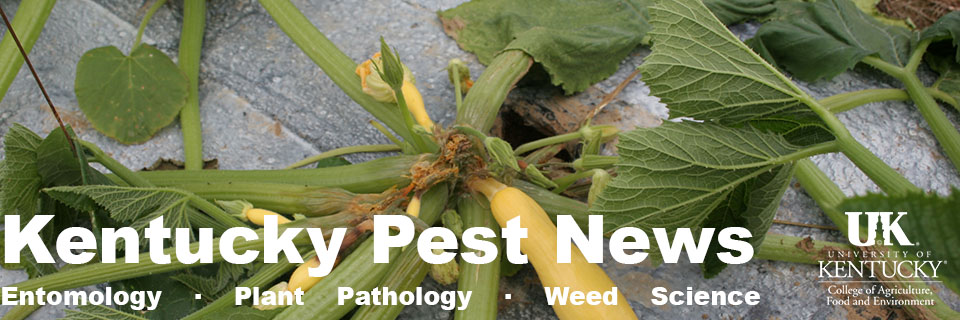The soybean cyst nematode (SCN) (Figure 1) causes greater annual yield losses in Kentucky than any other pathogen of soybean. The last time a formal survey was conducted by the University of Kentucky in 2006 and 2007, approximately 76% of…
Monthly Archives: October 2019
Awooo! Wolf Spiders of Kentucky
Wolf spiders get a bad rap. They are common spiders, found under logs and rocks, as well as in open areas. They are also active hunters, meaning that they don’t spin a web like some of their more famous relatives.…
If the Glove Doesn’t Fit (the job!), You Must Quit
Many pesticides require the use of gloves during one or more pesticide-handling or early-entry operations in order to reduce pesticide exposure. Often, it is our hands that are most likely to become contaminated when handling pesticides. But different pesticides may…
EPA Proposes an Update to the WPS Application Exclusion Zone Regulations
The EPA has proposed changes to the Worker Protection Standard (WPS) pesticide Application Exclusion Zone (AEZ) requirements. The changes would improve enforcement and simplify requirements for pesticide applicators on farms in complying with AEZ regulations. The Application Exclusion Zone requirement,…
Poinsettia Diseases (PPFS-GH-06)
Poinsettias grown for Christmas sales are vulnerable to various destructive diseases that may develop anytime during production, from propagation to sales. This fact sheet discusses some of the fungal and bacterial diseases that can infect greenhouse-grown poinsettias, including symptoms, cause,…
Plant Disease Diagnostic Lab Highlights
The following plant disease highlights have been compiled from samples submitted to the University of Kentucky Plant Disease Diagnostic Laboratories from October 1 to October 29, 2019. Diagnostic samples of agronomic crops have included soybean stem borer on soybean; Pythium…
Elements of Good Pesticide Storage
With the outdoor growing season winding done, applicators are storing pesticides until next year. Storing these pesticides properly helps to protect your investment and protect other persons and environment. Because the amount of pesticides stored varies considerably from farm to…
Brown Patch in Home Lawns & Commercial Turfgrass (PPFS-OR-T-12)
Brown patch, also known as Rhizoctonia blight, is a common disease of turfgrass. All cultivated grasses grown in Kentucky can be affected; however, this disease is usually only destructive in tall fescue and perennial ryegrass. Fine fescues and Kentucky bluegrass…
Rose Rosette Disease (PPFS-OR-W-16)
Rose rosette is a devastating disease that is a threat to virtually all cultivated roses (Rosa spp.) in Kentucky, regardless of cultivar. Even rose cultivars known for their exceptional disease resistance and hardiness are susceptible to rose rosette disease. Losses…
Leaf Scorch and Winter Drying of Woody Plants (PPFS-OR-W-17)
Leaf scorch symptoms can develop whenever water needed for plant growth is insufficient, or when water is lost from leaves faster than it can be replaced from the soil. Not only can this condition occur on deciduous trees and shrubs…
Tachinid Flies Might Have Been Actively Working this Season in Kentucky
This past July I observed tachinid flies around conglomerations of June bugs and Japanese beetles while tallying insects in industrial hemp fields (Figure 1). Yaziri Gonzalez (graduate student in Entomology) collected stink bugs in soybean fields in central and western…
Heligen® is Registered under Section 24(c) to Manage Corn Earworm in Industrial Hemp in Kentucky
A naturally occurring baculovirus (Helicoverpa zea nucleopolyhedrovirus) with the commercial name of Heligen® was registered in Kentucky under FIFRA Section 24(c) (Heligen 24c KY190041 SLN Acknowledgement Letter_20190925). This is a highly specific virus used to control corn earworm (Helicoverpa zea)…
The Fall Field Cricket, a Singing Invader
According to the calendar, we are entering the autumnal portion of 2019, even if it definitely doesn’t feel like it here in Kentucky. Hopefully, temperatures will start dropping soon and we can enjoy apple picking, pumpkin carving, and cricket singing!…
Diagnosing Plant Problems – Kentucky Master Gardener Manual Chapter 7 (ID-194)
When plant problems arise, determining the source of these issues can be challenging. Living (biotic) factors such as plant pathogens, insects, and wildlife can damage plants. In addition, non-living (abiotic) factors, such as weather, physical damage, nutrition, and chemical injury…
2019 Insect Trap Counts
Trap counts for major insect pests are provided by the Kentucky IPM Program. Traps are located at the UK Research and Education Center in western Kentucky and the UK Spindletop Farm in Lexington. Below are trap counts for the current…
